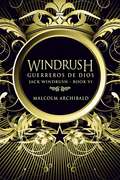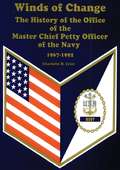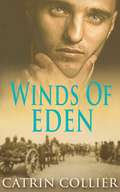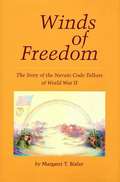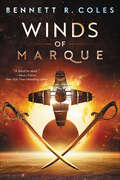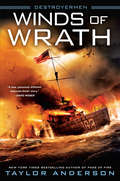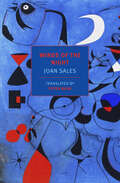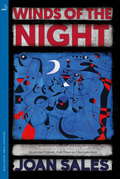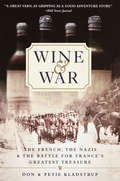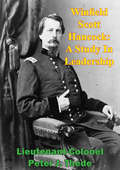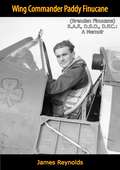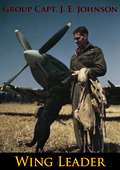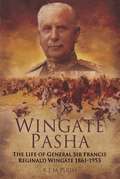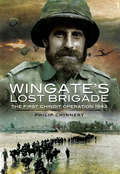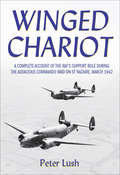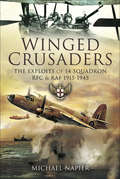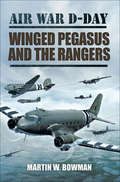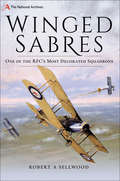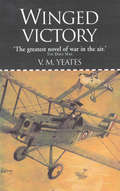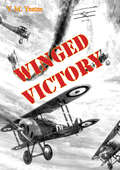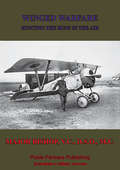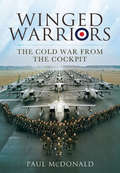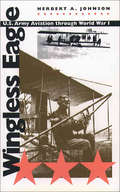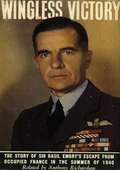- Table View
- List View
Windrush: Guerreros de Dios
by Malcolm ArchibaldAños después de abandonar el regimiento 113, Jack Windrush es enviado a la frontera noroeste de la India para investigar informes de pistolas entre las tribus pashtunes. Cuando descubre que los informes no solo son específicos, sino que son más profundos de lo que específicamente se cree, se le asigna que detenga al grupo rebelde y evite un levantamiento. Pronto, los viejos amigos se convertirán en enemigos mortales y la lealtad se convertirán en un bien escaso. A medida que la revuelta islámica contra los británicos se levanta a través de la frontera, ¿pueden Jack y su unidad detener el levantamiento rebelde?
Winds of Change: The History of the Office of the Master Chief Petty Officer of the Navy 1967-1992
by Charlotte D. CristWhen the Office of the Master Chief Petty Officer of the Navy was created in 1967, the U.S. Navy took a giant step forward in untapping the leadership capabilities of its enlisted force. In the act of adding an extra gold star to a master chiefs crow, the senior levels of command were, in effect, saying to the enlisted community, we respect and value your opinion, we need your input, and we will listen and act.And just as they have met the challenges of war and peace for more than two centuries, the enlisted community has responded in a way that not only silenced the “doubting Thomases,” but amazed those who initially believed. No one could have known 25 years ago that the office would grow into the position of influence and credibility it enjoys today. No officer, regardless of his position in the chain of command or Washington bureau, demands more respect, gains quicker access, or is listened to more intently than the Master Chief Petty Officer of the Navy. Wise Congressmen, Secretaries of Defense and the Navy, Chiefs of Naval Operations, and Naval Personnel and many, many others have benefited from the sage counsel of the MCPON. For his voice is not only the voice of personal experience, but of the broad and ever-changing spectrum of the enlisted experience.Seven men have survived “the winds of change.” They learned when to bend and when to stand firm. They adjusted, adapted, and adhered. Nonetheless, they refused to change one common denominator that has served them well throughout their voyage to the top. They continued to practice loyalty up, and loyalty down. They learned a keen sense of balance on the high wire on which we placed them: that bridge between the Officers and the Enlisted.In each and every sailor serving the U.S. Navy today lies the potential to be a Master Chief Petty Officer of the Navy and the opportunity to make the world’s finest Navy just a bit better for their shipmates.-Print ed.
Winds of Eden
by Catrin CollierWith the dreaded Family Reunion looming over her head - and a broken heart to boot - Augusta Josephine Burnette takes matters in hand and leaves her hometown for a job in a seaside resort. The setting is elegance incarnate, but the atmosphere says something else entirely. With her innate sense of adventure (and just plain nosiness), AJ sets out to unravel exactly what - and who -the Mirmar Resort is hiding. AJ begins to think that time spent with her crazy family might not be as lethal as the time spent at the Miramar, and she makes an effort to leave. Thankfully, her cousin Ellie, a self-described psychic, has come along for the ride, and between the two of them, a very underhand plan is brought to light - and a murderer is nabbed.
Winds of Freedom: The Story of the Navajo Code Talkers of World War II
by Margaret BixlerThe Beginnings, The World of the Code Talkers, The Language and The Code, From Boot Camp to Action, 1941-1946, Island by Island Across the Pacific, Back Home: Honors and Problems, Epilogue: Personal Reflections, 1991.
Winds of Marque: Blackwood And Virtue (Blackwood & Virtue)
by Bennett R. ColesIn a dense star cluster, the solar winds blow fiercely. The star-sailing ship HMSS Daring runs at full sheet on a secret mission from the Emperor himself: to hunt down and destroy a festering pirate threat. Armed with a letter of marque allowing them to collect the bounty of enemy vessels, the crew has been told to find the pirates’ base by any means necessary.Dashing second-in-command Liam Blackwood and plucky quartermaster Amelia Virtue lead the infiltration of shady civilian merchant networks to gather intelligence, all while keeping Daring’s true identity hidden. But trouble begins when Daring’s enigmatic captain makes a series of questionable choices and rumblings of discontent ripple up from the crew. Liam and Amelia must discover the truth about their commander, their mission, and the real enemy threat before they fall prey to the very pirates they’re supposed to be tracking.
Winds of Wrath (Destroyermen #15)
by Taylor AndersonMatt Reddy and the crew of the USS Walker are positioned to push the line of battle to the breaking point on an alternate Earth, in the thrilling return to the New York Times bestselling Destroyermen series.Matt Reddy and his sailors have fought, bled, and died for their Lemurian friends and other allies from across time, but their enemies are still operational. In Africa, the Grik General Esshk has escaped defeat to build a new army and new weapons, and is desperate enough to use them to destroy the world if he can't have it.In South America, the NUS, General Shinya, and the Army of the Sisters have the evil Dominion on the ropes and are closing in on the seat of its blood-drenched power, but the twisted Don Hernan has struck a deal with the fascist League, and Victor Gravois is finally assembling the awesome fleet of modern ships he's always craved. If he's successful, the war will be lost. Undermined by treachery on a stunning scale, Matt Reddy must still steam his battered old ship halfway around the world, scraping up what forces he can along the way, and confront the mightiest armada the world has ever seen in a fiery duel to the death.
Winds of the Night
by Joan SalesThe sequel to Joan Sales' great novel of the Spanish Civil War, Uncertain Glory, this follow-up takes a provocative look at post-war Catalonia through the eyes of a chaplain struggling with his faith in the aftermath of brutal destruction.Winds of the Night is the follow-up, published almost thirty years later, to Joan Sales's acclaimed masterwork of the Spanish Civil War, Uncertain Glory. It describes the shell-shocked wasteland that was postwar Catalonia through the eyes of Cruells, a Republican chaplain who survives the war and completes his theological studies only to lose his faith in a world where it seems all hope has been extinguished.As Cruells struggles to function as a rural priest, his steps are dogged by ghostly figures from his past, such as Lamoneda, a fascist agent provocateur. Against his wishes, Cruells is drawn into obsessive dialogues about the war in which only lunacy prevails, for Lamoneda seems to possess the key to the whereabouts of an old friend—the mercurial Juli Soleràs, whose charisma, for all his betrayals, still holds Cruells in thrall.A delirious, excoriating performance, comparable in spirit to the work of Thomas Bernhard, Winds of the Night offers a phantasmagorical vision of a traumatized country caught in the vise of fascism.
Winds of the Night (MacLehose Press Editions #8)
by Joan Sales"Perhaps the worst thing about war is the peace that follows . . ."Winds of the Night is the follow-up, published almost thirty years later, to Joan Sales' acclaimed masterwork of the Spanish Civil War, Uncertain Glory.It describes the shell-shocked wasteland that was post-war Catalonia through the eyes of Cruells, a Republican chaplain who survives the war, and completes his theological studies only to lose his faith in a world where it seems all hope has been extinguished.As he struggles to function as a rural priest, his steps are dogged by a ghostly figures from his past, such as Lamoneda, a fascist agent provocateur who now hobnobs with Himmler and misses few opportunities to turn the febrile post-war atmosphere to his financial advantage. Against his wishes, Creulls is drawn into obsessive dialogues about the war in which only lunacy prevails, for Lamoneda seems to hold the key to the whereabouts of an old friend - the mercurial Juli Soleràs, whose charisma, for all his betrayals, still holds Cruells in thrall.An essential coda to the modern classic that is Uncertain Glory, Winds of the Night is a Beckettian vision of the traumas of combatants and country hidden beneath the rhetoric of the victors.Translated from the Catalan by Peter Bush
Wine and War: The French, the Nazis, and the Battle for France's Greatest Treasure
by Petie Kladstrup Donald KladstrupThe remarkable untold story of France's courageous, clever vintners who protected and rescued the country's most treasured commodity from German plunder during World War II. "To be a Frenchman means to fight for your country and its wine." -Claude Terrail, owner, Restaurant La Tour d'Argent. In 1940, France fell to the Nazis and almost immediately the German army began a campaign of pillaging one of the assets the French hold most dear: their wine. Like others in the French Resistance, winemakers mobilized to oppose their occupiers, but the tale of their extraordinary efforts has remained largely unknown-until now. This is the thrilling and harrowing story of the French wine producers who undertook ingenious, daring measures to save their cherished crops and bottles as the Germans closed in on them. Wine and War illuminates a compelling, little-known chapter of history, and stands as a tribute to extraordinary individuals who waged a battle that, in a very real way, saved the spirit of France.
Winfield Scott Hancock: A Study In Leadership
by Lieutenant-Colonel Peter J. ThedeThe purpose of this study is to identify and analyze the leadership competencies of Major General Winfield Scott Hancock, the most consistently successful corps-level commander of the Civil War. Over the course of his 44 years in uniform, General Hancock participated in the Mexican War, Civil War, and Indian Wars. He was the candidate of the Democratic Party in the 1880 Presidential election. Nicknamed "Hancock the Superb", he was recognized as the best combat commander in the Army of the Potomac. Remaining a general in the Regular Army after the Civil War, Hancock played a major role in post-war affairs. In order to gain insight into Hancock's leadership competencies, DA Pamphlet 600-80 and Field Manual 22-103 will be used as a framework. Research will chronologically follow aspects of Hancock's life and career to identify skills as they are developed and employed.
Wing Commander Paddy Finucane (Brendan Finucane) R.A.F., D.S.O., D.F.C.: A Memoir
by James ReynoldsThis book was first published in 1942 as a tribute to Irish-born RAF fighter pilot and flying ace, Brendan Finucane (1920-1942), who died fighting for Britain during World War II.Known amongst his colleagues as “Paddy,” Finucane was credited with 28 aerial victories—five probably destroyed, six shared destroyed, one shared probable victory, and eight damaged—and was also noted for being the youngest person ever given command of a fighter wing in the history of aerial combat, namely the Hornchurch Wing.“IF SOMEONE asked me to describe Wing Commander Brendan Finucane R.A.F. in two words, I would say “bright and shining.” He seemed always to radiate light and lift of the spirit—his frequent smile, the way the corners of his generously drawn mouth went up—his witty friendly eyes—even his crisp dark red hair seemed always lifted by a breeze from “the upper air” he loved so well, the upper air in which from his eighteenth birthday until the day of July seventeenth, nineteen hundred and forty-two, he spent the greater part of his waking life. This smiling friendliness, this winning manner, caused him to be known as “Paddy” to all the world.”—JAMES REYNOLDS
Wing Leader
by Group Capt. Douglas Bader Group Capt. J. E. JohnsonThe thrilling story of the top scoring Allied fighter pilot of World War II 'Johnnie' Johnson, who served with Fighter Command squadrons throughout the war, scoring his 38th and final victory in September 1944. From the moment the author joins his first operational Spitfire squadron in August 1940, the reader is taken on an epic journey through the great aerial fighter actions of the war including the Battle of Britain, sweeps across the Channel and over France, Dieppe and Normandy; and finally, operations across the Rhine and into Germany itself."No one who wants to know what the air war was really like--anyway from the point of view of the fighter squadrons--can afford not to read this book by one of the most deservedly famous fighting officers in the short but glorious history of the R.A.F."The story, of course, is magnificent--the record of the brilliantly successful fighting career, from the Battle of Britain to victory in Germany, of the man who shot down more enemy fighters than any other R.A.F. officer. Group Commander Johnson writes nearly as well as he flies and fights--which is saying a good deal....A modest, straightforward, often superbly graphic account of nearly five years of fighting in the air."--Marshal of the Royal Air Force Sir John C. Slessor, FLIGHT Magazine"...will delight the professional airman and give the layman a view of combat air war that is rarely seen in a 'popular' account."--Air Force Magazine"Some of the best descriptions of combat in the air during World War II. The book is filled with many episodes that move as swiftly as Spitfires and Hurricanes...enough solid action to satisfy the most ardent adventure fan. At the same time he outlines air force training, planning and combat so skillfully that his well-written book is also a valuable treatise on the subject."--The New York Sunday Times Book Review"...absorbing and well-written personal account. A highly interesting narration of the human side of an airman's life throughout the war."--Herald Tribune Book Review
Wingate Pasha: The Life of General Sir Francis Reginald Wingate, 1861–1953
by R.J.M PughWingate Pasha is the first biography of an eminent Scottish soldier-statesman who contributed much to the development of the Sudan and Egypt during the late 19th and early 20th centuries. It tells the story of a man from an impoverished background with a rudimentary education who nonetheless mastered several foreign languages including Arabic. In 1884, Wingate joined the expeditionary force to relieve Khartoum, which arrived two days too late, General Gordon having been murdered. As Kitcheners Military Intelligence Officer, Wingate was instrumental in assisting Kitchener to recover Sudan from Dervish domination. As Governor-General of the Sudan, Wingates enlightened administration brought unprecedented political, social and economic prosperity to the Sudanese people. in the First World War, Wingate played a leading role in organising the Arab Revolt against the Turks, although it was his subordinate, T E Lawrence (of Arabia) who received the acclaim. After the war, as High Commissioner of Egypt, he continued to seek justice for the Egyptian people at the Paris Peace Conference which led to the signing of the Treaty of Versailles in 1919.He retired from public life to Dunbar in Scotland and had a successful business career until he died in 1953.
Wingate's Lost Brigade: The First Chindit Operations, 1943
by Philip D. ChinneryWith the Japanese seemingly unbeatable after their conquest of Malaya, Singapore, Thailand and much of Burma, Orde Wingates plans to conduct long range deep penetration operations behind Japanese lines in Burma were audacious to say the least. His Chindit operations (so called after Chindwin River) were hugely demanding on those taking part who suffered terrible deprivation in the harsh climatic and jungle conditions. While costly in terms of lives lost, the operations inflicted damage to the Japanese and raised Allied morale. The author has compiled a fascinating account of Wingates 77 Brigade using the personal accounts of survivors, as well as Wingates own report and post-war interrogation of Japanese generals. A remarkable story emerges of survival, courage and extreme hardship. The author evaluates the successes and failures of the mission.
Winged Chariot: A Complete Account of the RAF's Support Role During the Audacious Command Raid on St Nazaire, March 1942
by Peter LushAn impeccably researched examination of the role the RAF played during this epic World War II raid in German-occupied France. In what has been described as &“the greatest raid of them all,&” Operation Chariot saw heavy destruction of the enemy-occupied port of St. Nazaire by British forces. With focus on the planning and actions of the operation, Peter Lush explores the three functions carried out by the RAF: the sweeping of the Bay of Biscay, the diversionary raid, and protecting the withdrawing survivors. He also outlines the importance of the photographic Reconnaissance Unit to the raid and the development of the Bomber and Coastal Commands particularly though the sorties flown by Coastal Command two days before the attack started. The book also highlights the tragedy that occurred for the RAF, when diversionary raids were carried out in impossible conditions; resulting in the loss of aircraft across Yorkshire and in the Channel. Lush examines whether this could have been prevented if the RAF had not been marginalized during the planning process of Operation Chariot. This timely and ultimate account, written by an expert who has collated over forty years worth of research, is an essential work for all those interested in military aviation, particularly during the Second World War.&“Highly recommended for anyone interested in learning more about the history of World War II, and the unsung heroes.&” —IPMS/USA
Winged Crusaders: The Exploits of 14 Squadron RFC & RAF, 1915–45
by Michael NapierFormed in 1915, and still operational today, 14 Squadron is one of the RAF's longest serving and most senior Squadrons. Spending the first thirty years of its operational life in the Middle East, the history of this Squadron is a rich one, but one which, until now, has gone largely unrecorded. Napier effectively brings together all the historical scraps and shreds of stories which make up the collective history of this unit, from 1915 –1945, a period of great military and social upheaval. The author himself attests to the fact that the work is not merely about the aeroplanes operational history during this period, or the stark military facts (although enthusiasts of both these areas will find much here); rather, the work concerns itself to a large extent with the people who flew such aircraft. Recording the dramatic trials and tribulations of the people who were 14 Squadron, Napier provides a sympathetic and engaging account of this period of Military History.
Winged Pegasus and the Rangers: Winged Pegasus And The Rangers (Air War D-Day)
by Martin W. BowmanThis is the third volume of a comprehensive five part work, detailing every aspect of air and paratroop operations on the night of 5/6 June 1944. The 6th Airborne Division was to support British Second Army and First Canadian Army; its task was to seize and hold the left flank of the bridgehead. The 5th Parachute Brigade was to seize the ground each side of the bridges over the Canal du Caen and the Orne River, whilst on the same day seize and hold positions on the long wooded ridge beyond the waterways, running from Troarn in the south to the sea. This ridge with the bridges behind would eventually form the critical left flank of the army and the bridges had to be intact to permit Allied troops and supplies to pass easily back and forth. The 3rd Parachute Brigade, which included the 1st Canadian Parachute Battalion (1,800 men) was to prevent enemy reinforcements moving towards the British beachhead. Another Battalion and the 1st Canadian Brigade had to destroy five bridges in the flooded valley of the Dives. The 9th Battalion had to silence a battery of four concrete gun emplacements on high ground near the village of Merville, 3 miles east of Ouistreham. For these tasks 38 and 46 Groups RAF dispatched 264 aircraft and 98 glider combinations, the glider tugs being Albemarles, Dakotas, Halifaxes and Stirlings, the gliders mainly Horsas with a few Hamilcars (carrying light tanks and 17-pounder anti-tank guns). Meanwhile, Brigadier Lord Lovats 1st Special Service Brigade, composed of four Army and one Royal Marines Commando, reached Pegasus Bridge en route to help other units of the Airborne Division.Allied intelligence had pinpointed 73 fixed coastal gun batteries that could menace the invasion. At Pointe-du-Hoc, a cliff rising 100 feet high from a very rocky beach, a six-gun battery which potentially could engage ships at sea and fire directly onto Utah and Omaha was taken by three companies (225 men) of the US 2nd Ranger Battalion using rocket propelled grapple hooks attached to climbing ropes and portable extension ladders to scale the cliffs within ten minutes after landing and capture the position.This dynamic episode in the history of D-Day is expertly researched and relayed with both style and reverence for the aircrew who participated in proceedings. A plate section of rare black and white images supplement the text, working further to create a real sense of the times at hand at this most pivotal point in the history of D-Day.
Winged Sabres: One of the RFC's Most Decorated Squadrons (The\national Archives Ser.)
by Robert A. SellwoodWinged Sabres is the story of a RFC & RAF squadron flying the cumbersome FE2 from February 1916 to September 1917, and then the superlative Bristol Fighter: a two-seater fighter-reconnaissance squadron with an astonishingly high success rate.20 Squadron was possibly the highest scoring squadron of the war and one of the most highly decorated, claiming over 600 combat victories with well over 400 confirmed in RFC & RAF Communiqus. Its members won seventy gallantry decorations including a posthumous Victoria Cross, and included fliers from the U.K. and around the world. Over 40 became aces, including the American Iaccaci brothers and some Canadians and others. But with a casualty rate of around 50% including killed, wounded and POW they paid a high price.Over 15 years research has gone into this book, covering a seldom-explored aspect of WW1 in the air: the two-seater fighter-reconnaissance squadrons. 20 Squadrons motto was Facta Non Verba Deeds Not Words!
Winged Victory (Echoes Of War Military History Ser.)
by V.M. YeatesExperience the chilling combat of World War I from inside an early biplane in this classic novel, by a pilot who lived through the war himself. France, 1914. The war on the land is taking to the skies . . . Pilot Tom Cundall is ready to take on the enemy in his trusty Camel fighter plane. But as he sees more and more planes shot down in flames, he begins to question the war, and what, or who, he is fighting for. There is no bitter snarl nor self-pity in this classic novel about the air war of 1914-1918, based very largely on the author&’s experiences. Combat, loneliness, fatigue, fear, comradeship, women, excitement—they all are part of a brilliantly told story of war and courage by one of the most valiant pilots of the then Royal Flying Corps.Praise for Winged Victory&“The greatest novel of war in the air.&” —The Daily Mail (UK)&‘Beautifully written with a poet&’s eye as well as a pilot&’s eye.&” —Evening Echo (UK)&“Not only one of the best war books . . . but as a transcription of reality, faithful and sustained in its author&’s purpose of re-creating the past life he knew, it is unique.&” —Henry Williamson, author of Tarka the Otter
Winged Victory [Illustrated Edition]
by V. M. YeatesIncludes Aerial Warfare During World War I Illustrations Pack with 115 maps, plans, and photos."There is no bitter snarl nor self-pity in this classic novel about the air war of 1914-1918, based very largely on the author's experiences. Combat, loneliness, fatigue, fear, comradeship, women, excitement -- all are built into a vigorous and authentic structure by one of the most valiant pilots of the then Royal Flying Corps.REVIEWS'The greatest novel of war in the air.'--Daily Mail'Beautifully written with a poet's eye as well as a pilot's eye.'-- Southern Evening Echo'The only book about flying that isn't flannel.'--Anonymous Fighter Pilot'Not only one of the best war books...but as a transcription of reality, faithful and sustained in its author's purpose of re-creating the past life he knew, it is unique.'--Henry Williamson, author of Tarka the Otter."-Print ed.
Winged Warfare - Hunting The Huns In The Air [Illustrated Edition]
by Major Billy Bishop V.C. D.S.O. M.C.[Illustrated with 17 additional photos of the author and the machines he flew and fought against]As a young Billy Bishop looking up into the sky above his Canadian trench in July 1915, a passing Royal Flying Corps aircraft was returning home from patrol. He was envious and said to whoever was listening "...it's clean up there! I'll bet you don't get any mud or horse **** on you up there. If you die, at least it would be a clean death.". Struck by his sudden epiphany he requested a transfer to the Royal Flying Corps, it was a momentous decision, for within the next three years Bishop would claim 72 victories over his German opponents, making him the highest scoring British Empire air ace of the First World War.A National Hero in his native Canada, he was awarded a V.C. for conspicuous services - the citation read:"For most conspicuous bravery, determination, and skill. Captain Bishop,...[On his own] flew first of all to an enemy aerodrome; finding no machines about, he flew on to another aerodrome...which was at least 12 miles the other side of the line. Seven machines....were on the ground. He attacked these from about fifty feet...One of the machines got off the ground, but at a height of 60 feet, Captain Bishop fired 15 rounds into it at very close range, and it crashed to the ground. A second machine got off the ground, into which he fired 30 rounds at 150 yards range, and it fell into a tree. Two more machines then rose from the aerodrome. One of these he engaged at a height of 1,000 feet, emptying the rest of his drum of ammunition. This machine crashed 300 yards from the aerodrome, after which Captain Bishop emptied a whole drum into the fourth hostile machine, and then flew back to his station. Four hostile scouts were about 1,250 feet above him for about a mile of his return journey, but they would not attack. His machine was very badly shot about by machine gun fire from the ground."A fine memoir from an Air Ace legend.
Winged Warriors: The Cold War from the Cockpit
by Thomas McDonaldPaul McDonald is a former RAF fast-jet pilot whose flying career spanned 34 years. He is not a typical senior RAF officer having been brought up on a council estate in a bleak northern industrial town. He became a pilot by accident and struggled to gain his wings. He spent 14 years on operational tours overseas including 2 tours at the height of the Cold War on a Tornado tactical nuclear squadron in Germany, only 15 minutes from responding to an anticipated Soviet onslaught. Earlier he served on a low-level photo reconnaissance squadron on NATO's vulnerable southern flank. He was decorated for gallantry in 1980 and later served in Kuwait as the Senior RAF Adviser, including Operation Desert Fox, the air war against Iraq in 1998.
Wingless Eagle
by Herbert A. JohnsonAt the start of the twentieth century the United States led the world in advances in aviation, with the first successful engine-powered flights at Kitty Hawk, North Carolina, and Dayton, Ohio, beginning in 1903. Fifteen years later, however, American airmen flew European-designed aircraft because American planes were woefully inadequate for service on the Western Front. Why was the United States so poorly prepared to engage in aerial combat in World War I? To answer this question, Herbert Johnson takes a hard look at the early years of U.S. military aviation, exploring the cultural, technical, political, and organizational factors that stunted its evolution. Among the recurring themes of Johnson's narrative are the damaging effects of a chronic lack of governmental funding for military aeronautics and the disruptive influence of a civilian "aeronaut constituency" both on military discipline and on public and Congressional attitudes toward army aviation. In addition, the Wright brothers' patent litigation hindered the technical development of American aircraft and crippled the domestic aviation industry's manufacturing capacity. Wartime experience helped correct some of these problems, but the persistence of others left the postwar Air Service with an uncertain and stormy future.
Wingless Victory: The Story of Sir Basil Embry’s Escape from Occupied France in the Summer of 1940
by Anthony RichardsonWINGLESS VICTORY is the story of an audacious and desperate man on the run, the record of one of the first wartime escapes through Occupied France. It reads like a first-class thriller and, as one critic puts it, "leaves fiction gasping far behind." On May 27, 1940, Wing-Commander Basil Embry (later Air Chief Marshal Sir Basil Embry, and Commander, Allied Air Forces in Central Europe 1953-56), although appointed to a higher command, decided to lead his old squadron into battle for the last time. Within the hour he was shot down in France and found himself alone, unarmed, and in uniform. Capture was inevitable. He was, in fact, captured three times, but refused to submit. Once he broke from a column of prisoners under the muzzle of a German machine-gun. Another time he fought his way out, killing three Germans with a stolen rifle and then hiding in a manure heap for nearly six hours. But perhaps the most amazing of all his exploits was the occasion on which, in the role of a fanatical member of the Irish Republican Army, he shook his fist under the nose of a German inquisitor, yelling hatred and abuse of Britain until his captors finally turned him loose to find his own way home. At this period there was little of escape technique to guide him and he had no opportunity to lay plans or prepare equipment. Yet, by sheer courage and wit, he found his way back to Britain to fight and fly again. He won the D.S.O. and three bars, and the D.F.C."The author succeeds in communicating vividly, yet unpretentiously, the sensations of a man on the run....About ten times as exciting as a fictional thriller."--Sunday Times"A thrilling and authentic escape story--will prove a classic."--Daily Herald"The records of World War II have no wilder or stranger story to tell."--Tatler"It is an extremely exciting story, but well spiced with humour as well."--Illustrated London News
